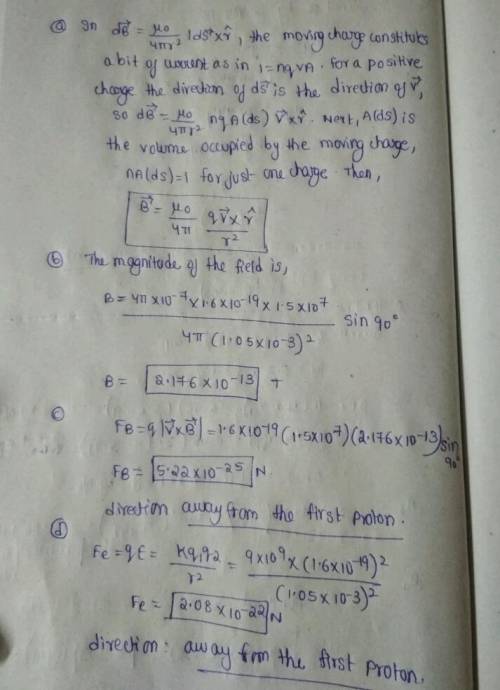
As seen, any object with electric charge, stationary or moving, other than the charged object that created the field, experiences a force in an electric field. Also, any object with electric charge, stationary or moving, can create an electric field. Similarly, an electric current or a moving electric charge, other than the current or charge that created the field, experiences a force in a magnetic field, and an electric current created a magnetic field.
a. To understand how a moving charge can also create a magnetic field, consider a particle with charge q moving with velocity v. Define the position vector r = r. r leading from the particle to some location. Show that the magnetic field at that location is
B= µo/4π= qv x r/r^2
b. Find the magnitude of the magnetic field 1.05 mm to the side of a proton moving at 1.50 x 10^7 m/s.
c. Find the magnetic force on a second proton at this point, moving with the same speed in the opposite direction.
d. Find the electric force on the second proton

Answers: 2
Other questions on the subject: Physics

Physics, 21.06.2019 20:00, Theacefamily123
When someone slams her books on a table the kinect energy is transferred into vibrations that travel to your ears as sound waves which statement describes the movement of those waves
Answers: 1

Physics, 22.06.2019 04:50, andrewsaul04
The position of a crate sliding down a ramp is given by x=(0.05t^3) m, y=(1.7t^2) m, z=(6−0.85t^5/2) m, where t is in seconds. (a) determine the magnitude of the crate's velocity when t = 2 s. (b) determine the magnitude of the crate's acceleration when t = 2 s.
Answers: 2

Physics, 22.06.2019 16:30, CadenSkinner2003
Place several e-field sensors at a few points on different equipotential lines, and look at the relationship between the electric field and the equipotential lines. which statement is true? 1-at any point, the electric field is perpendicular to the equipotential line at that point, and it is directed toward lines of higher voltages. 2-at any point, the electric field is perpendicular to the equipotential line at that point, and it is directed toward lines of lower voltages. 3-at any point, the electric field is parallel to the equipotential line at that point.
Answers: 1
Do you know the correct answer?
As seen, any object with electric charge, stationary or moving, other than the charged object that c...
Questions in other subjects:

English, 05.05.2020 13:20





Mathematics, 05.05.2020 13:20

History, 05.05.2020 13:20

English, 05.05.2020 13:20


Mathematics, 05.05.2020 13:20







